Nyheter
Ozempic can’t help your overweight in big tech: Global ETF diversification ideas for 2024
Publicerad
1 år sedanden
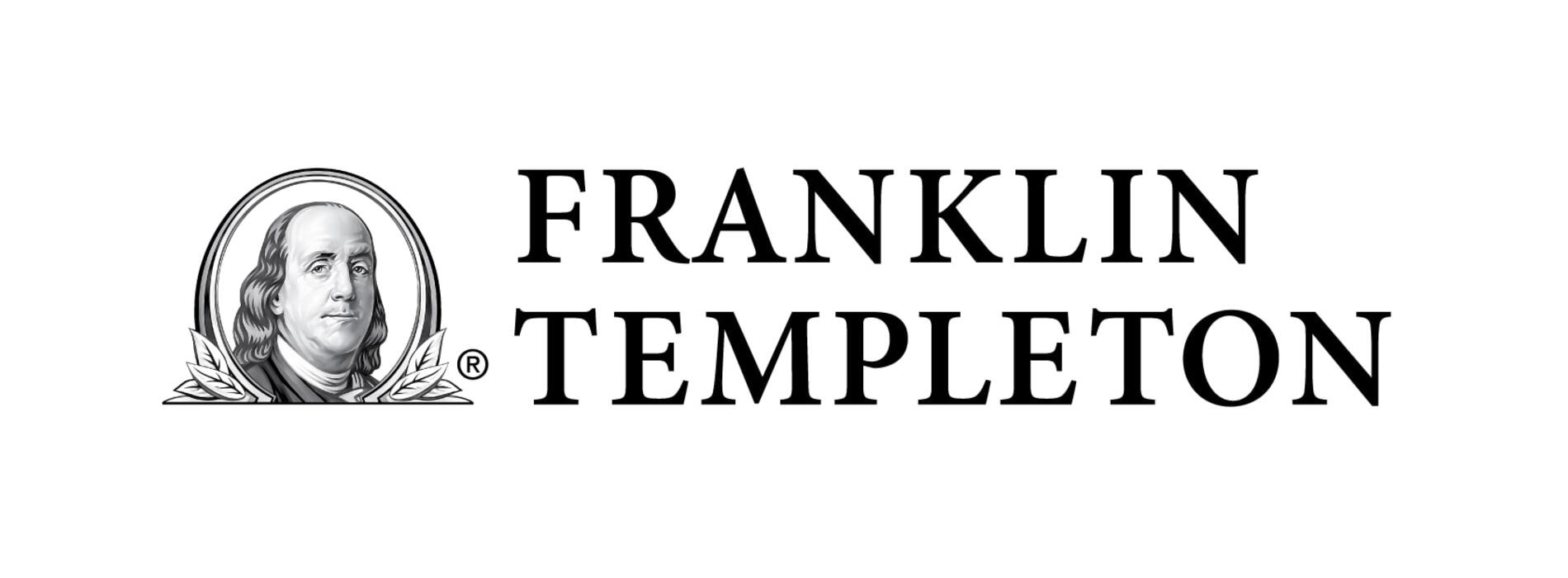
The start of a new year brings a chance for reflection and re-evaluation. For investors, a chance to rebalance. Franklin Templeton ETFs’ Dina Ting and Marcus Weyerer highlight the pitfalls of overweight exposure to mega tech stocks and where in the world to look for diversification in 2024.
Key takeaways
• The artificial intelligence (AI) race has sustained record high-concentration ratios for the S&P 500 Index, but also pose risks.
• The 2024 election avalanche may create short-term economic divergence globally and market volatility.
• Nearshoring benefits Mexico, less so Canada, while Brazil’s low sub-10x price-to-earnings valuation still presents opportunities, in our analysis.
• Asia offers diverse investment opportunities, with the semiconductor cycle looking up in South Korea and Taiwan.
If you’re sitting down to take in some investment projections for 2024, perhaps you’re already anticipating some trending keywords and have a (mental) bingo card of buzzwords in mind. Give yourself credit if you can check off #Magnificent7 given all the chatter over how top-heavy the S&P 500 Index has become and whether the “Magnificent Seven” (Alphabet, Amazon, Apple, Meta, Microsoft, Nvidia and Tesla) stocks are worthy of their rich valuations.
We do foresee the AI theme buoying such mega tech companies, regardless of how well their stocks may continue performing into the new year. But keep in mind that the top-10 stocks of the S&P 500 make up almost one-third of the index’s market capitalization, with the Magnificent Seven comprising well over a quarter of market cap and contributing almost all of its year-to-date appreciation.1 Be mindful of this “magnificent” overconcentration, which also means that the United States accounts for more than 60% of the MSCI All Country World Index (ACWI).2
On the other side of the globe is the world’s largest consumer of semiconductor chips—China. Even as its markets struggle with cyclical weakness, and the United States continues to lead the global AI innovation race, this revolutionary technology is quickly being deployed across China. Areas such as Beijing, Shenzhen and Shanghai have been ramping up aspirations to become the Middle Kingdom’s AI talent hub alongside other regional hotspots like India, which boasts accommodating policy and skilled but cheap labor. Strategic investors might therefore want to consider their US equity allocations for 2024 with a view toward reducing record-high concentration ratios and the need to factor in risks such as 2024’s busy calendar of economically consequential elections across major global powers.
Importantly next year, some four billion people—over half of the world’s population—will head for polling stations to cast ballots for general, regional or local elections scheduled in more than 70 countries.
Taiwan’s election in January is expected to be a flashpoint in the Sino-US relationship; in the spring, India’s Prime Minister Narendra Modi appears set for a third term with a high approval rating following a pivotal year that showcased the country’s global ascendancy; and undoubtedly the outcome of US elections late in 2024 have the potential to bring the most far-reaching consequences of all.
Data for US markets show that over the longer term, however, presidential election outcomes tend to have very little impact on market moves (typically, the widest range of possible market outcomes relative to other periods of the election cycle occur during the uncertain 12 months preceding election day).3 With current volatility in the low teens, we see the risk of politically induced spikes throughout the year. Historically, the 12 months leading up to elections post an average volatility of 17% in years when the same party continues its hold on the White House; in years when the presidency flips, that figure rises to over 20%. Given the fraught political backdrop, we may see a more nervous market than what is currently priced.
Whatever the election outcome, we expect it to reverberate across key global regions, especially in Asia. Considering the economic uncertainties pertaining to inflation and the US rates trajectory, we expect investors will continue to become ever-more selective about the emerging markets (EM) that they choose for 2024.
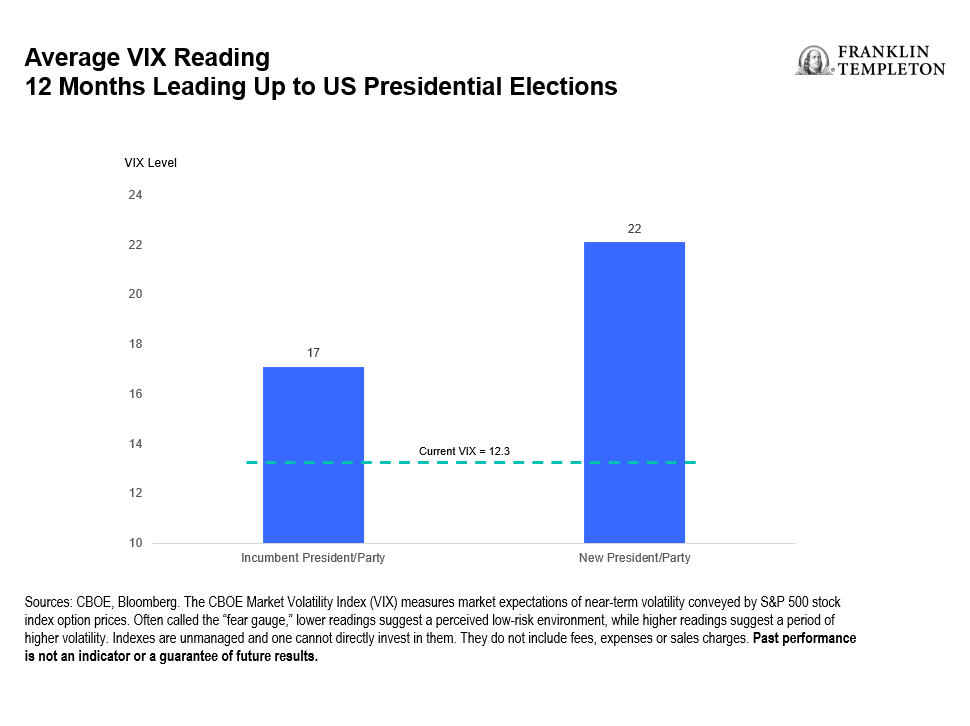
So if your new year planning involves revisiting the effect of US home bias on portfolio diversification, we suggest investors consider how beneficial low-cost country and regional exchange-traded funds (ETFs) can be as tools for implementing targeted global asset allocation. In our opinion, passive country ETFs and alternatively weighted solutions like multifactor exposures, tailored for precise implementation, can make sense for many investors in this environment.
For 2024, we believe investors should bear in mind the following considerations:
Love thy neighbor—Canada and Mexico (perhaps, just not equally)
Since pandemic disruptions prompted urgency over fortifying and diversifying resilient supply chains closer to end consumers, nearshoring trends have served to benefit US neighbors—Canada and Mexico. While a slew of new trade agreements, such as increased partnerships relating to the supply of critical minerals and other essential goods, present multilateral benefits, nearshoring has especially been a boon to Mexico. Canada’s economic growth meanwhile has struggled this year, although the good news is that inflation there is cooling, according to central bank officials, who left the country’s policy interest rate unchanged at 5% in early December.
Healthy demand trends have helped Mexico’s Manufacturing Purchasing Managers Index (PMI) see a steady uptick in recent years. Total new orders increased, and Mexican manufacturers collectively recorded the strongest combined upturn in sales in just under five years.4 In contrast, Canada’s manufacturing sector downturn has continued to deepen due to cost pressures, falling new orders and softer sales.
Divergence (of performance returns, in this case) is probably another good word for 2024. Year-to-date, the FTSE Canada RIC Capped Index is up +9.4%, while the FTSE Mexico RIC Capped Index gained +31%, outperforming the S&P 500 (+24.5%).5 Weighted toward the consumer staples and financials sectors, the Mexican benchmark saw its biggest returns come from retail giants and conglomerates that are tapped into branded beverage bottling and distribution. One of Latin America’s largest drink industry firms has also been finding success in leveraging access to customers of its ubiquitous convenience store chain with new digital debit cards that may help financial services penetration—a central government priority.
A bill aimed at revamping national stock exchanges to boost trading, approved by Mexico’s congress recently, also bodes well for Latin America’s second-largest economy.
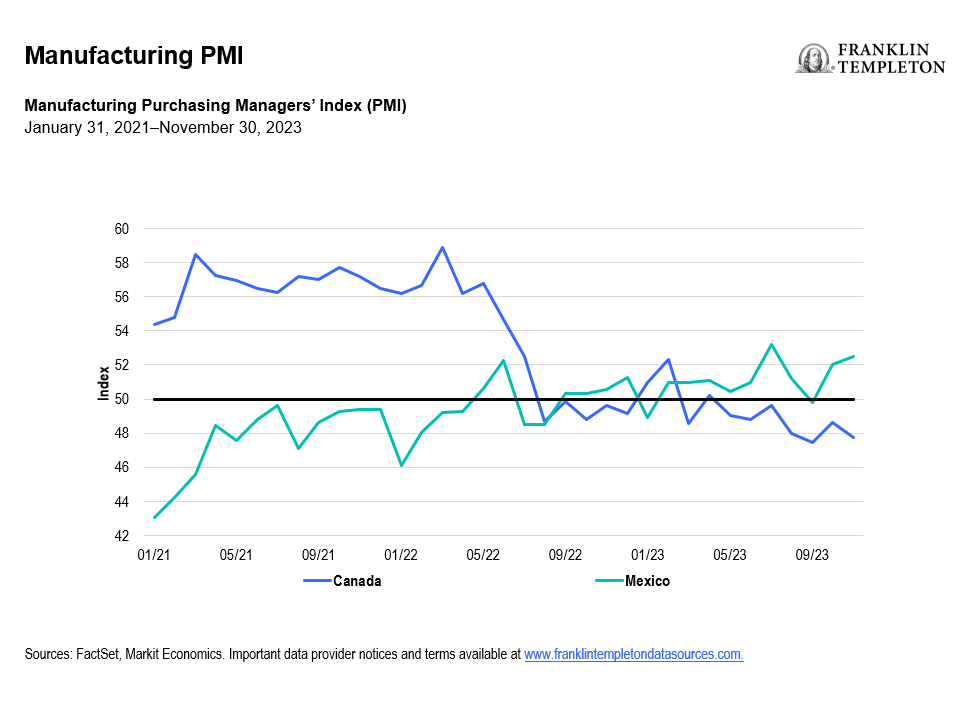
Opportunities in Asia
If your focus on Asia in 2023 concentrated mainly on Japan’s market, you’re not alone as the region’s diverse universe of economies may be underappreciated in portfolios. We’ve written this year about dynamic India—one of the fastest-growing major countries with solid short-term and long-term prospects. India, which has surpassed China as the world’s most populous nation, is likely to have a larger gross domestic product (GDP) than Japan in 2026, according to recent International Monetary Fund projections.6 While Japan is expected to be the world’s fifth-largest economy between 2026 and 2028, India’s nominal GDP (measured in USD terms) is projected to outrank both Germany and Japan by 2028. The world’s most populous nation celebrated several recent milestones in space exploration and fortified its assertiveness on the world stage, flaunting diplomatic clout as host of the G20 summit in September 2023.
Elsewhere in Asia, key exporting markets Taiwan and South Korea add first class technological capabilities, while Hong Kong and Singapore are two of the world’s preeminent financial centers and trading hubs. Indonesia is the fourth most populous nation, boasts the largest economy in Southeast Asia and accounts for roughly one-fifth of global nickel reserves. It is poised to play a key role in the electric vehicle supply chain. Many of these economies are well-placed to benefit from the proliferating “China Plus One” approach to manufacturing. Redistributing China weightings across some of these players may make sense not only from a diversification angle, but also from an economic point of view.
Semiconductor supremacy
South Korea and Taiwan certainly punch above their weight on the global stage, thanks to their dominance in the semiconductor industry. In our assessment, this sector has likely gone through—or is currently going through—the recent cycle’s trough. The average duration of these cycles since 2000 lasted around 18 to 24 months, and given the latest peak occurred in 2021, we are optimistic about 2024. Typically, South Korea and Taiwan have tended to perform well following an industry trough. The 12-month return for both markets after a cycle low has averaged around 30%, vs. 23% for broad EM. Bear in mind, of course, that the COVID-19-induced technology rally somewhat distorts these figures, and the sample size is small with just five cycles (from 2000–2021) observed. More importantly, however, both economies also appear set to benefit from more long-term structural drivers that increase chip demand. Besides #AI (another key phrase), there is the Internet of Things (the online interconnection of computing devices embedded in everyday physical objects) and the Metaverse (an interactive and immersive world powered by several digital technologies via virtual and mixed reality).
In December 2023, South Korean President Yoon Suk Yeol heralded a strengthening “semiconductor alliance” with the Netherlands during a four-day visit there. That same month, Dutch chip equipment giant ASML and South Korea’s Samsung Electronics agreed to make a new major joint investment to build a plant in South Korea for the production of high-tech semiconductor processing technology for cutting-edge chips.
In the short term, we believe valuations in these economies remain elevated, especially compared to China. Taiwan’s exports, especially technology and AI-related, have been robust, while non-technology exports showed weakness. Overall, however, growth predictions for both South Korea and Taiwan of between 2% to 3% for 2024 are an improvement over 2023.7
Elsewhere in EM
Brazil
Brazil also had a positive 2023, with its market, as measured by the FTSE Brazil RIC Capped Index, up about +36% for the one-year period to December 15, 2023, versus about 7.5% for broader EM, as measured by the FTSE Emerging Index.8 Strength in the agricultural and mining sectors for Latin America’s resource-rich, largest nation (by population) has also boosted GDP growth to above pre-COVID levels. While the headline GDP growth for 2024 is expected to be a step down from 2023’s numbers, we see exciting opportunities in Brazil—a large sub-10x price-to-earnings market.
Credited for proactively raising interest rates early on during the pandemic, Brazil’s independent central bank has done well in its battle with inflation. We recently offered commentary about Brazilian equities in relation to the price of oil, and we remain optimistic that investors may now find an attractive entry point to this bright spot among global equity markets.
Saudi Arabia’s transformation is being driven by the Kingdom’s Vision 2030 framework, which provides a comprehensive economic and social blueprint for its long-term reform goals. Among its competitive advantages are its investment strength and strategic geographic location connecting three continents. And of course, it remains home to the world’s largest oil producer. In recent decades, the share of Middle Eastern exports going to China and India has risen given Asia’s increased appetite for oil, up about five-fold, according to the International Monetary Fund. Meanwhile, that share to Europe and America has slipped to 16%.
OPEC+ countries have faced recent setbacks in nudging oil prices higher; however, ongoing Middle East conflicts, including the Israel-Hamas war and Yemen Houthi rebel attacks on Red Sea tankers, complicate the outlook for oil production.
Beyond energy, Saudi Arabia has also attempted to diversify its economy to broaden its exports and investment potential with major sporting events, tourism, infrastructure and entertainment. This included the introduction of tourist visas in late 2019 and may bode well for its market next year. Dominated by the financials, materials and energy sectors, the FTSE Saudi Arabia RIC Capped Index was up 11% for the one-year period to December 15, 2023.9 Albeit somewhat controversial, Saudi Arabia appears set to host the 2034 World Cup, which would make it only the second Arab Gulf country to ever host the tournament, after Qatar in 2022.
In summary, we believe investors should be mindful of portfolio overconcentration risks. Given so many upcoming major elections in 2024, the potential for short-term market volatility remains. Irrespective of related changes to politics and policy, significant economic trends can impact market swings, making selective diversification and targeted country selection even more important for the new year.
By Dina Ting, Head of Global Index Portfolio Management, and Marcus Weyerer, Senior ETF Investment Strategist, Franklin Templeton ETFs
Appendix
- Sources: Bloomberg, S&P. As of December 15, 2023. Indexes are unmanaged and one cannot directly invest in them. They do not include fees, expenses or sales charges. Past performance is not an indicator of future results. See www.franklintempletondatasources.com for additional data provider information.
- Sources: Bloomberg, S&P. As of December 15, 2023. The MSCI ACWI is a free float-adjusted, market capitalization-weighted index designed to measure the equity market performance of global developed and emerging markets. Indexes are unmanaged and one cannot directly invest in them. They do not include fees, expenses or sales charges. Past performance is not an indicator of future results. See www.franklintempletondatasources.com for additional data provider information.
- Sources: Haver Analytics, FactSet, Fidelity. As of November 14, 2023.
- Source: S&P Global. December 1, 2023.
- Source: Bloomberg. As of December 15, 2023. The FTSE Canada RIC Capped Index represents the performance of Canadian large- and mid-capitalization stocks. The FTSE Mexico RIC Capped Index represents the performance of Mexican large- and mid-capitalization stocks. Securities are weighted based on their free float- adjusted market capitalization and reviewed semi-annually. Indexes are unmanaged and one cannot directly invest in them. They do not include fees, expenses or sales charges. Past performance is not an indicator of future results. See www.franklintempletondatasources.com for additional data provider information.
- Source: IMF’s World Data Mapper. October 2023. There is no assurance that any projection, estimate or forecast will be realized.
- Source: Korea Development Institute, Economist Intelligence Unit 2023.
- Source: Bloomberg. As of December 15, 2023. The FTSE Brazil RIC Capped Index represents the performance of Brazilian large- and mid-capitalization stocks. Securities are weighted based on their free float- adjusted market capitalization and reviewed semi-annually. The FTSE Emerging Index measures the performance of the most liquid large- and mid-cap companies in the emerging markets. Indexes are unmanaged and one cannot directly invest in them. They do not include fees, expenses or sales charges. Past performance is not an indicator of future results. See www.franklintempletondatasources.com for additional data provider information.
- Source: Bloomberg. As of December 15, 2023. The FTSE Saudi Arabia RIC Capped Index represents the performance of Saudi Arabian large- and mid-capitalization stocks. Securities are weighted based on their free float- adjusted market capitalization and reviewed semi-annually. Indexes are unmanaged and one cannot directly invest in them. They do not include fees, expenses or sales charges. Past performance is not an indicator of future results. See www.franklintempletondatasources.com for additional data provider information.
Du kanske gillar
-


Svenskarna har en ny favorit-ETF
-


Amerant Investments går in i Europa med lanseringen av en aktiv Latin American Debt ETF
-


Indiens digitala boom: EMQQ Globals ETF-möjlighet
-


De spanska fonder som gick bäst i januari
-
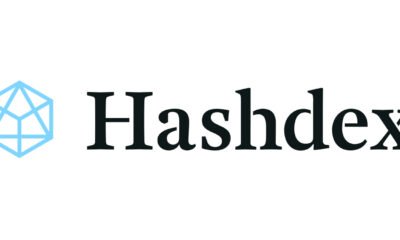

Crypto tumbles on tariff developments
-


HANetfs VD kommenterar att guldet nådde all-time high
Nyheter
Sju börshandlade fonder som investerar i försvarssektorn
Publicerad
7 timmar sedanden
6 april, 2025
Att investera i försvarssektorn och rustning har upplevt en oöverträffad tillväxt de senaste åren. Sedan krigsutbrottet i Ukraina 2022 har västländerna börjat prioritera militära utgifter, där Nato uppmanar sina medlemmar att avsätta minst 2 % av sin BNP till försvar.
Denna ansträngning återspeglas i en ökning med 30 procent av EUs försvarsutgifter mellan 2021 och 2024, och nådde 326 miljarder euro 2024 (1,9 procent av EUs BNP).
Sektorn har gått från att betraktas som ”tabu” på finansmarknaderna till att bli en strategisk tillgång för investerare. Medan amerikanska teknikaktier, kända som ”Magnificent 7” (Apple, Amazon, Alphabet, Meta, Microsoft, Nvidia och Tesla), har sett nedgångar med 8 procent 2025, har europeiska försvarsaktier stigit i vissa fall så mycket som 46 procent hittills i år, vilket har ökat specialiserade ETFer för försvar och säkerhet.
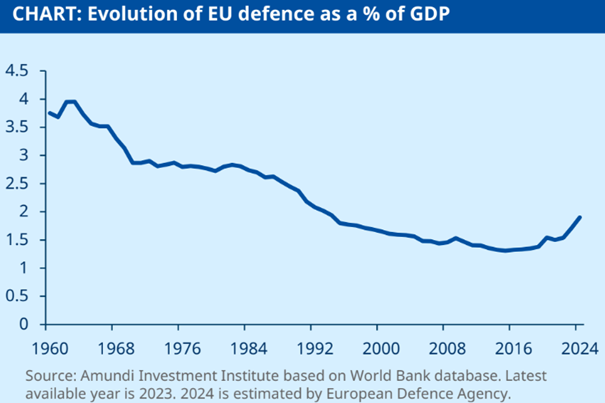
Försvarsutgifterna i Europa har ökat efter år av nedgång. Källa: Amundi Investment Institute
Europa tar kontroll över sin säkerhet
Europeiska kommissionen har lanserat planen ReArm Europe, som syftar till att mobilisera 800 miljarder euro för att stärka kontinentens militärindustri. Ursula von der Leyen motiverade detta med att hävda behovet av ”ett säkrare och motståndskraftigt Europa”, en hållning som förstärks av USAs tvetydiga politik i kriget i Ukraina och växande misstro mot Nato.
Detta paket inkluderar åtgärder som att utesluta militära utgifter från stabilitets- och tillväxtpakten, samt gemensam försvarsfinansiering genom överstatliga mekanismer.
I mars godkände den tyska förbundsdagen en grundlagsändring för att häva skuldbromsen, som infördes 2009.
Parlamentsledamöter har godkänt ett paket på 500 miljarder euro för att reformera landets infrastruktur, främja klimatinitiativ och öka försvarsutgifterna.
Historiskt beroende av USAs skydd står Europa nu inför en ny verklighet. Enligt Didier Borowski, chef för makroekonomisk politik på Amundi Investment Institute, har kontinenten gått in i ”en ny era där Europa måste ta ansvar för sin egen säkerhet”.
Men utmaningarna är inte små. Som Gilles Moëc, chefsekonom på AXA IM, påpekar: ”Även om försvarspaketet som presenterades av Ursula von der Leyen förblir ofullständigt vid denna tidpunkt, skulle erbjudandet att utesluta militära utgifter från det europeiska ramverket för finansiell tillsyn ha varit otänkbart för bara några veckor sedan.”
För sin del beskriver Clément Inbona, fondförvaltare på La Financière de l’Échiquier (LFDE), denna mentalitetsförändring som ”starten på ett decennium av stark tillväxt.” Enligt honom är den europeiska försvarssektorn inte längre ett tabubelagt ämne för investerare och är på väg att etablera sig som en strategisk pelare i kontinentens ekonomi.
Men övergången kommer inte att bli lätt. Inbona pekar ut tre viktiga hinder:
- Budget: Många europeiska länder har gått med på att öka sina militära utgifter, men de måste fortfarande hitta ett sätt att finansiera det utan att skapa finanspolitiska kriser.
- Fragmenterad industri: För närvarande är den europeiska försvarssektorn uppdelad på flera nationella tillverkare. En gemensam strategi saknas fortfarande för att konsolidera den.
- Hållbarhet och etiska investeringar: Militärindustrin har i åratal kringgåtts av hållbara investeringsfonder. Denna uppfattning håller dock på att förändras.
Det är denna tredje punkt, den etiska, som förvaltare och investerare granskar. Aliki Rouffiac, portföljförvaltare på Robeco, påpekar dilemmat: ”Vi försöker förena en naturlig motvilja att investera i försvar, på grund av dess koppling till konflikt, med det faktum att vi är investerare med flera tillgångar och vill balansera risk, avkastning och hållbarhet i försvarsutgifterna […] The ReArm Europe-planen representerar massiva nya investeringar för att värna om den nuvarande försvarsdelens tyngd och 2 %. exponering i Global Equity Index, medan andra delar av marknaden också kommer att dra nytta av ökade utgifter.”
Strukturell trend eller övergående modefluga?
För många analytiker är denna boom i den europeiska försvarsindustrin bara början på en långsiktig trend. Aneeka Gupta, chef för makroekonomisk forskning vid WisdomTree, påpekar att kapplöpningen för att stärka den europeiska försvarskapaciteten redan är igång:
”Sedan invasionen av Ukraina har europeiska ledare intensifierat sina krav på ökade försvarsutgifter. Europa, som länge har förlitat sig på amerikanska säkerhetsgarantier, står nu inför en kritisk vändpunkt.” Uppgifterna stöder Guptas uppfattning:
- Europeiska entreprenörers orderböcker har nått historiska toppar. Försäljningstillväxt på 11 % och vinst på 16 % prognostiseras för perioden 2024-2029.
- Statliga åtaganden: Med långsiktiga kontrakt och ytterligare utgifter säkerställda är efterfrågesynlighet stark.
- EUs strategiska självständighet: Europeiska kommissionens EDIS-plan syftar till att se till att 50 % av försvarsupphandlingarna är europeiskt tillverkade 2030 och 60 % 2035.
Borowski varnar dock för att effekten på den europeiska BNP-tillväxten återstår att se: ”I USA har försvarsutgifterna en stark multiplikatoreffekt på ekonomin. I Europa är denna påverkan mindre eftersom 70 % av medlemsländernas militära inköp fortsätter att göras utanför kontinenten. Utmaningen är att utveckla en enad försvarsindustri.”
Farväl Magnificent 7, hej European STARS?
Försvarssektorn i Europa har fått en aldrig tidigare skådad framträdande plats på aktiemarknaderna. Med Inbonas ord: ”Glöm Magnificent 7, den där slutna klubben av amerikanska börsnoterade titaner kopplade till teknologi och i synnerhet AI. Den nya börsens sensation är ’Le(s) S.T.A.R.S.'” Denna akronym syftar på sex stora europeiska försvars- och flygbolag: Leonardo, Saab, Rhein, Thales, Airbus, och Airbus. Dessa företag har varit de främsta förmånstagarna av paradigmskiftet inom europeisk säkerhet, med ökningar som vida överträffar benchmarkbörsindex.
Ett tydligt exempel är Rheinmetall, vars värde har skjutit i höjden med 80 % till 2025 och med nästan 1 000 % under de senaste tre åren. Som Alexis Bienvenu, fondförvaltare på LFDE, påpekar, påminner denna återuppkomst av vapenindustrin om ”Rhinegold” i den nordiska mytologin: ”Europa har just återupptäckt detta guld. Kommer det att ta det, medvetet om konsekvenserna av dess handlingar? Detta guld heter nu Rheinmetall, Leonardo, Thalès, Thalès och A, och har nått hela Europa – tidshöjder, som till och med överträffar det spektakulära framförandet av ”Magnificent Seven” av amerikansk teknologi.”
eToro, å sin sida, lägger till BAE Systems till ekvationen för att ”kvadra” jämförelsen med Magnificent Seven. Det så kallade ”European Defense 7” har överträffat S&P 500 och STOXX 600 under varje senaste period, med en avkastning som överstiger 268 % under de senaste fem åren.
7 ETFer som investerar i försvarssektorn 2025: Sektorns boom har skapat ett förnyat intresse för försvars-ETFer, med produkter som sammanför dessa stora företag och andra i branschen.
Nedan delar vi upp sju av dessa instrument placerade i en blomstrande sektor, rankade från lägsta till högsta lönsamheten hittills i år.
WisdomTree Europe Defense
Den senaste av alla, lanserades så sent som i mars 2025, därför har den ännu ingen historik eller ackumulerad avkastning. WisdomTree Europe Defence UCITS ETF – EUR Acc sticker ut som den första börshandlade fonden som uteslutande fokuserar på europeiska försvarsföretag.
Denna ETF strävar efter att spåra resultatet för företag som är involverade i den europeiska försvarsindustrin, inklusive tillverkare av civilförsvarsrelaterad utrustning och produkter. Dessutom utesluter det företag som är inblandade i kontroversiella vapen som är förbjudna enligt internationell lag och de som bryter mot standarderna i FNs Global Compact, sa företaget i sin lansering för några dagar sedan.
Invesco Defence Innovation
Invesco Defence Innovation UCITS ETF spårar S&P Kensho Global Future Defense Index, som spårar prestanda för globala företag som är dedikerade till innovation inom militär- och försvarssektorn. ”Fondens investeringsmål är att ge exponering mot börsnoterade globala företag som utvecklar sofistikerade vapen, defensiva system och andra lösningar för att skydda gränser”, står det i ETFens prospekt.
Det är mer en teknologibörshandlad fond än en ren investering i traditionella försvarsföretag. I själva verket faller det i kategorin teknik-ETFer. Därför är dess lönsamhet den lägsta hittills under 2025 av alla analyserade ETFer.
Den börshandlade fondens nettovärde är 11,6 miljoner euro.
iShares Global Aerospace & Defence UCITS ETF USD (Acc)
iShares Global Aerospace & Defence UCITS ETF syftar till att återspegla resultatet för S&P Developed BMI Select Aerospace & Defence Index, som består av ledande företag inom den globala flyg- och försvarssektorn. Den börshandlade fondens tillgångar i Europa är cirka 270 miljoner euro.
Denna ETF ger därför investerare en mer fokuserad exponering mot företag som tillverkar och distribuerar flygplan, samt tillverkare av komponenter och utrustning för försvarsindustrin, inklusive militärflygplan och radarutrustning.
First Trust Indxx Global Aerospace & Defence UCITS ETF
First Trust Indxx Global Aerospace & Defence UCITS ETF följer Indxx Global Aerospace & Defense Index, som även inkluderar företag från hela världen som är dedikerade till flyg- och försvarsindustrin. Fonden erbjuder investerare exponering mot företag som är verksamma inom tillverkning och distribution av flygplan och försvarsutrustning. Fondens tillgångar är cirka 3,6 miljoner euro i Europa, en av de minsta på listan.
HANetf ICAV – Future of Defence UCITS ETF
HANetf ICAV – Future of Defence UCITS ETF fokuserar på företag som utvecklar avancerad teknologi och innovativa lösningar inom försvarsområdet, inklusive cybersäkerhet. Denna fond täcker områden som cybersäkerhet, artificiell intelligens och autonoma system.
Fondens tillgångar är cirka 1,155 miljarder euro i Europa.
VanEck Defence ETF A USD Acc
VanEck Defence UCITS ETF, som lanserades i mars 2023, har upplevt en betydande tillväxt och ökade med 55 % 2024 och nästan 21 % i början av 2025.
Dess huvudsakliga innehav inkluderar företag som Palantir Technologies, Thales, Booz Allen Hamilton och Leonardo, med tillgångar under förvaltning på cirka 2,537 miljarder euro, vilket gör den till den ETF med flest medel under förvaltning av alla analyserade.
Global X Defence Tech UCITS ETF USD Acc
Global X Defence Tech ETF är också relativt ny (initierad i september 2024) och är specialiserad på företag som utvecklar nästa generations försvarsteknologier. Denna fond erbjuder investerare exponering mot företag som är involverade i utvecklingen av avancerade vapensystem, cyberförsvar och annan teknologi som är avgörande för nationell säkerhet.
Fondens tillgångar i Europa är endast 36,4 miljoner euro.
Utöver detta har även HANetf meddelat att företaget arbetar med att lansera en ETF som skall investera i försvarssektorn. Namnet är ännu okänt, men den skall handlas under kortnamnet ARMY i London och 8RMY på tyska Xetra.
Detta innehåll har utarbetats under redaktionella kriterier och utgör ingen rekommendation eller investeringsförslag. Att investera innehåller risker. Tidigare resultat är ingen garanti för framtida resultat.
Nyheter
Investera i olja med hjälp av börshandlade fonder
Publicerad
8 timmar sedanden
6 april, 2025
Med ETFer har du inte bara möjlighet att investera i aktier eller obligationer. Du kan också investera i olja och många andra råvaror. Det finns dock några saker du bör veta: råvaru-ETFer spårar alltid en hel korg av olika råvaror, som täcker åtminstone några av följande segment:
- Energi: olja och gas
- Ädelmetaller: guld, silver och platina
- Industriella metaller: t.ex. zink och koppar
- Jordbruk: inklusive vete och kaffe
- Boskap: levande nötkreatur och magra svin
Varför det inte finns några olje-ETFer i de flesta europeiska länder
Det finns inga olje-ETFer som har hemvist inom EU. Detta beror på det regelverk som definieras av UCITS-direktivet. Enligt dessa riktlinjer ska ett index, och därmed även motsvarande ETFer, alltid ge en minsta grad av diversifiering och får inte bestå av endast en komponent. Följaktligen tillåter inte bestämmelser i EU lansering av en olje-ETF.
Om du vill investera i olja som en enskild råvara kan du göra det via Exchange Traded Commodities (ETC). Det finns när detta skrivs 13 olika index på olja som spåras av 17 olika börshandlade produkter. Den årliga förvaltningskostnaden för dessa börshandlade produkter ligger på mellan 0,25 och 1,25 procent.
Swapbaserad olja ETC
ETCer spårar värdet på råolja baserat på terminskontrakt. Olje-ETCer backas upp med säkerheter, som vanligtvis kontrolleras dagligen. Säkerheten är i form av kontantinvesteringar eller värdepapper med högsta kreditvärdighet.
Olje-ETCer är ett lämpligt instrument för att delta i prisutvecklingen på olja. Tänk dock på att du investerar i terminskontrakt och inte direkt i olja. Olje-ETCer spårar priset på antingen Brent-råolja, som kommer från Nordsjön, eller West Texas Intermediate (WTI) från USA. I den här investeringsguiden hittar du information om alla de ETCer som låter dig investera i olja.
Olje-ETF/ETC i jämförelse
När man väljer en olje-ETF eller ETC bör man överväga flera andra faktorer utöver metodiken för det underliggande indexet och prestanda för en ETF. För bättre jämförelse hittar du en lista över alla olje-ETFer/ETCer med detaljer om namn, kortnamn, förvaltningskostnad, utdelningspolicy, hemvist och replikeringsmetod.
För ytterligare information om respektive börshandlad fond, klicka på kortnamnet i tabellen nedan.
Alla dessa börshandlade produkter handlas på tyska Xetra.
Det betyder att det går att handla andelar i dessa börshandlade produkter genom de flesta svenska banker och Internetmäklare, till exempel Nordnet, SAVR, DEGIRO och Avanza.
| Namn ISIN | Kortnamn | Avgift % | Utdelnings- policy | Hemvist | Replikerings- metod |
| WisdomTree Brent Crude Oil JE00B78CGV99 | OOEA | 0.49% | Ackumulerande | Jersey | Swapbaserad |
| WisdomTree WTI Crude Oil GB00B15KXV33 | OD7F | 0.49% | Ackumulerande | Jersey | Swapbaserad |
| WisdomTree WTI Crude Oil – EUR Daily Hedged JE00B44F1611 | 00XM | 0.49% | Ackumulerande | Jersey | Swapbaserad |
| BNPP ICE Brent ÖL ETC DE000PS701L2 | BNQA | 0.90% | Ackumulerande | Holland | Swapbaserad |
| WisdomTree Bloomberg WTI Crude Oil IE00BVFZGC04 | 0LJC | 0.25% | Ackumulerande | Irland | Swapbaserad |
| WisdomTree Brent Crude Oil – EUR Daily Hedged JE00B7305Z55 | 00XT | 0.49% | Ackumulerande | Jersey | Swapbaserad |
| BNPP WTI Öl (TR) ETC DE000PS7WT17 | BNQB | 0.90% | Ackumulerande | Holland | Swapbaserad |
| WisdomTree Bloomberg Brent Crude Oil IE00BVFZGD11 | 0LJD | 0.25% | Ackumulerande | Irland | Swapbaserad |
| BNPP RICI Enhanced Brent Öl (TR) ETC DE000PB6R1B1 | BNQC | 1.00% | Ackumulerande | Holland | Swapbaserad |
| BNPP RICI Enhanced Brent Crude Oil (ER) Index EUR Hedge ETC DE000PZ9REB6 | B4NY | 1.20% | Ackumulerande | Holland | Swapbaserad |
| BNPP RICI Enhanced WTI Öl (TR) ETC DE000PB6R1W7 | BNQD | 1.00% | Ackumulerande | Holland | Swapbaserad |
| WisdomTree Brent Crude Oil Longer Dated JE00B78CP782 | 00EB | 0.49% | Ackumulerande | Jersey | Swapbaserad |
| BNPP RICI Enhanced WTI Öl (ER) EUR Hedge ETC DE000PZ9REW2 | B4NZ | 1.20% | Ackumulerande | Holland | Swapbaserad |
| BNPP RICI Enhanced Brent Öl (TR) USD ETC DE000PR5RBU0 | BNQ7 | 0.99% | Ackumulerande | Holland | Swapbaserad |
| BNPP RICI Enhanced WTI Öl (TR) USD ETC DE000PR5RWU6 | B4NG | 0.99% | Ackumulerande | Holland | Swapbaserad |
| SG ETC Brent Crude Oil Futures-Kontrakt DE000ETC0696 | SGS2 | 0.90% | Ackumulerande | Tyskland | Swapbaserad |
| SG ETC Light Sweet Crude Oil (WTI) Futures-Kontrakt DE000ETC0779 | 42GG | 0.90% | Ackumulerande | Tyskland | Swapbaserad |
Nyheter
E0UA ETF mycket korta eurodenominerade statsobligationer
Publicerad
9 timmar sedanden
6 april, 2025
iShares EUR Government Bond 0-3 Month UCITS ETF EUR (Acc) (E0UA ETF) med ISIN IE000JLXYKJ8, försöker följa ICE 0-3 Month Euro Government Bill-index. ICE 0-3 Month Euro Government Bill-index följer statsobligationer utgivna av länder i euroområdet. Tid till förfall: 0-3 månader.
Den börshandlade fondens TER (total cost ratio) uppgår till 0,07 % p.a. iShares EUR Government Bond 0-3 Month UCITS ETF EUR (Acc) är den billigaste och största ETF som följer ICE 0-3 Month Euro Government Bill-index. ETFen replikerar resultatet för det underliggande indexet genom samplingsteknik (köper ett urval av de mest relevanta indexbeståndsdelarna).
iShares EUR Government Bond 0-3 Month UCITS ETF EUR (Acc) är en mycket liten ETF med tillgångar på 3 miljoner euro under förvaltning. Denna ETF lanserades den 27 november 2024 och har sin hemvist i Irland.
Varför E0UA?
- Direktinvestering i statsobligationer.
- Riktad exponering mot kortfristiga eurostatsobligationer.
- Regional statsobligationsexponering.
Investeringsmål
Fonden strävar efter att uppnå en total avkastning på din investering, med hänsyn till både kapital- och inkomstavkastning, vilket återspeglar avkastningen från ICE 0-3 Month Euro Government Bill Index, fondens jämförelseindex (”Index”).
Handla E0UA ETF
Shares EUR Government Bond 0-3 Month UCITS ETF EUR (Acc) (E0UA ETF) är en europeisk börshandlad fond. Denna fond handlas på flera olika börser, till exempel Deutsche Boerse Xetra.
Det betyder att det går att handla andelar i denna ETF genom de flesta svenska banker och Internetmäklare, till exempel DEGIRO, Nordnet, Aktieinvest och Avanza.
Börsnoteringar
| Börs | Valuta | Kortnamn |
| XETRA | EUR | E0UA |

Sju börshandlade fonder som investerar i försvarssektorn

Investera i olja med hjälp av börshandlade fonder

E0UA ETF mycket korta eurodenominerade statsobligationer

Fem börshandlade fonder för investeringar i healthcare : Den stora möjligheten 2025?

S5EW ETF är en likaviktad satsning på S&P500

Fonder som ger exponering mot försvarsindustrin

WisdomTree lanserar europeisk försvarsfond.

Warren Buffetts råd om vad man ska göra när börsen kraschar

De bästa börshandlade fonderna för tyska utdelningsaktier

Trumps återkomst får europeiska aktier att rusa
Populära
-

 Nyheter2 veckor sedan
Nyheter2 veckor sedanFonder som ger exponering mot försvarsindustrin
-

 Nyheter4 veckor sedan
Nyheter4 veckor sedanWisdomTree lanserar europeisk försvarsfond.
-
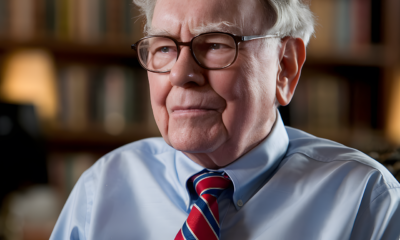
 Nyheter2 veckor sedan
Nyheter2 veckor sedanWarren Buffetts råd om vad man ska göra när börsen kraschar
-

 Nyheter3 veckor sedan
Nyheter3 veckor sedanDe bästa börshandlade fonderna för tyska utdelningsaktier
-

 Nyheter4 veckor sedan
Nyheter4 veckor sedanTrumps återkomst får europeiska aktier att rusa
-

 Nyheter6 dagar sedan
Nyheter6 dagar sedanSvenskarna har en ny favorit-ETF
-

 Nyheter3 veckor sedan
Nyheter3 veckor sedanHANetf lanserar Europa-fokuserad försvars-ETF
-

 Nyheter2 veckor sedan
Nyheter2 veckor sedanEn av de mest nedladdade finansapparna i Sverige


